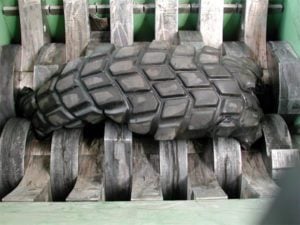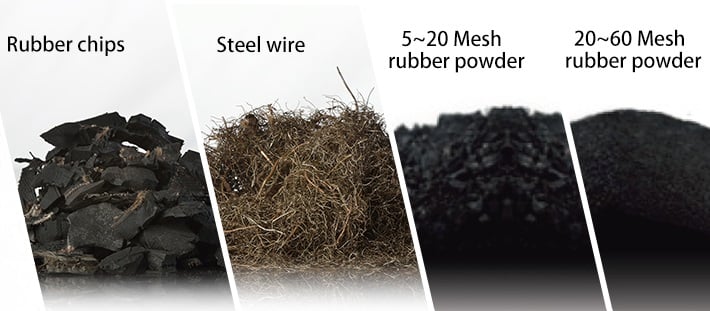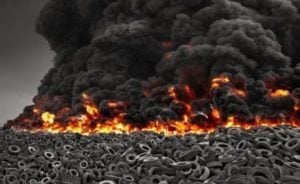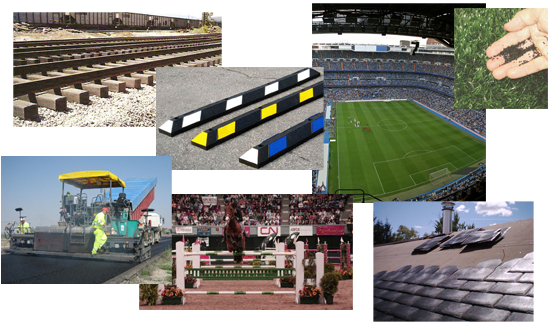Automobile tires recycled by:
- Using shredding and cryogenic grinding to turn the tires into a number of substances, like synthetic turf, playground floors, and road bank.
- Using other chemicals to break down the tires for claim rubber tire manufacturing.
- Using the approach of devulcanization that removes the sulphur from a used tire to make it harder.
- Treating the rubber with liquid nitrogen to make a fine powder out of it.
The Process of Getting Automobile Tires Recycled
The whole process of tire recycling involves the following steps:
- Collecting tires.
There are companies that buy used tires from individuals, gas stations, tire shops, etc. and resells them to processing plants for further operations. - Steel wire removing.
There are special steel (nylon, other material) tire wires in the rubber, inserted for resilience. The wire has to be removed beforehand in order to get automobile tires recycled. The revived steel is then used to produce other steel goods, and the rubber moves on to the next stage. - Whole tire processing.

A tire shredding machine
(source: tiresspa.com)The plants work on the tires by cutting them into 2-inch pieces and then treating them with chemicals to create fine powder, granules, etc. This part of tire processing may be done through one of the following systems:
- Mechanical.
A special machine grinds tires into pieces using the ambient process; the size is regulated by a special granulator. - Cryogenic.
Tires are frozen with liquid nitrogen and broken into crumbs by a hammer mill. The particles of steel are removed with a huge magnet, and all other fibers are taken out with air classifiers.
- Mechanical.
- Rubber screening.
The screening stage is necessary to ensure there is no wire or other contaminants left that can affect the further usage of the rubber. The stage also includes sorting the elements by size, or other characteristics if automobile tires are recycled using different methods. - Cleaning.
All the derived rubber is thoroughly cleaned using water and cleaning substances, so they are ready for packaging. The packaged rubber is then sold to any organization that needs to use reclaimed rubber, powder, granules, etc. for their purposes.
Recycled tire products (source: tirerecycling-machine.com)
How Much Recycled Tires Are Worth and How to Earn Money for Tire Disposal
You can get about $100 a day ($1-$40 per tire) by starting a tiny tire-collecting side business. You can do this in 3 ways:
- Collect tires from gas stations and auto shops.
You can drive to local gas stations and auto shops, pick up used AMP tires, for example, and get about $3 per tire.
After you have the tires, contact any company that gets automobile tires recycled or retreaded, and schedule further transportation. If you contact recycling facilities directly, they may charge you a fee of $1 per tire, but you will still have additional income. - Store tires.
You can offer your storing facility to gas stations and auto shops. Most of them will gladly use such a service because there are some issues related to storing old tires. For example, accoding to a California law, piles of scrap tires that have less than 500 items in them have to be located at a distance of at least 10 feet from lot lines and buildings. They can be located nearer, but only if an operator considers the fire hazard minimal. It’s not convenient for auto shops and stations to resolve all these issues.
Besides, some companies will come to pick up your tires from any place if you have at least 100 of them. - Selling your tires.
You can sell your old tires to retreading companies in any quantity. The income depends on the company and the number of tires you sell. In any case, you will dispose your used tires in a way that is helpful for you and the environment.
The best time to sell used tires is late summer to early fall. Retreaders start to work on winter “snow-caps” during this time, so they buy more used casings and often even pay more per item.
Scrap Tire Hazards
There are 6 main dangers used tires pose:
- They’re a loved breeding place for mosquitos, which can be virus carriers.
- Tires can become home for rodents, snakes, ticks, and other potential vectors.

source: burgundywave.com - They catch fire easily, can burn for months, and are almost impossible to extinguish.
- Tires take up much space, causing illegal dumping in other areas, often in woods and rivers.
- Piles of scrap rubber can cause injury or death of workers: the tires can roll and fall on people.
- Rubber can pollute ground water with toxins if put into the ground, causing dramatic consequences.
- Tires can trap gases of methane, creating a danger of them becoming buoyant or getting out to the surface.
The rate of scrapping tires is 1.1 tire per person, per year, which makes up about 300 million tires annually. Most of the tires are put into landfill, so recycling is crucial to eliminate the aforementioned dangers.
The Value of Getting Automobile Tires Recycled
Rubber is poisonous when just thrown away, contributing to the deterioration of the ecological situation. Fortunately, the piles of used and thrown away tires that could be found five years ago have almost vanished by now. About 90% of them are being used for recycling purposes. Nowadays, there many options of uses for recycled tires, starting with rubberized asphalt and barrier covers, and finishing with swings for kids, planters, and tools for sport fields.

Besides, the usage of recycled rubber makes 4-20 times smaller carbon footprints than the usage of virgin plastic resins. Therefore, it’s highly beneficial to get car tires recycled, contributing materials for different products and preventing the environment from further pollution.
